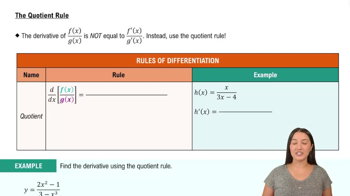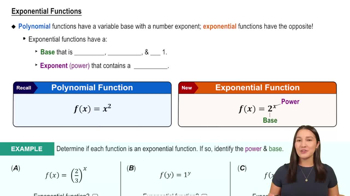For the following graph, find the open intervals for which the function is concave up or concave down. Identify any inflection points.
Table of contents
- 0. Functions7h 54m
- Introduction to Functions16m
- Piecewise Functions10m
- Properties of Functions9m
- Common Functions1h 8m
- Transformations5m
- Combining Functions27m
- Exponent rules32m
- Exponential Functions28m
- Logarithmic Functions24m
- Properties of Logarithms36m
- Exponential & Logarithmic Equations35m
- Introduction to Trigonometric Functions38m
- Graphs of Trigonometric Functions44m
- Trigonometric Identities47m
- Inverse Trigonometric Functions48m
- 1. Limits and Continuity2h 2m
- 2. Intro to Derivatives1h 33m
- 3. Techniques of Differentiation3h 18m
- 4. Applications of Derivatives2h 38m
- 5. Graphical Applications of Derivatives6h 2m
- 6. Derivatives of Inverse, Exponential, & Logarithmic Functions2h 37m
- 7. Antiderivatives & Indefinite Integrals1h 26m
- 8. Definite Integrals4h 44m
- 9. Graphical Applications of Integrals2h 27m
- 10. Physics Applications of Integrals 3h 16m
- 11. Integrals of Inverse, Exponential, & Logarithmic Functions2h 31m
- 12. Techniques of Integration7h 41m
- 13. Intro to Differential Equations2h 55m
- 14. Sequences & Series5h 36m
- 15. Power Series2h 19m
- 16. Parametric Equations & Polar Coordinates7h 58m
6. Derivatives of Inverse, Exponential, & Logarithmic Functions
Derivatives of Exponential & Logarithmic Functions
Problem 3.9.47
Textbook Question
15–48. Derivatives Find the derivative of the following functions.
f(x) = 2^x/2^x+1
 Verified step by step guidance
Verified step by step guidance1
Step 1: Identify the function f(x) = \( \frac{2^x}{2^x + 1} \). This is a quotient of two functions, so we will use the quotient rule to find the derivative.
Step 2: Recall the quotient rule for derivatives: If you have a function \( g(x) = \frac{u(x)}{v(x)} \), then the derivative \( g'(x) \) is given by \( \frac{u'(x)v(x) - u(x)v'(x)}{(v(x))^2} \).
Step 3: Assign \( u(x) = 2^x \) and \( v(x) = 2^x + 1 \). Now, find the derivatives \( u'(x) \) and \( v'(x) \).
Step 4: The derivative of \( u(x) = 2^x \) is \( u'(x) = 2^x \ln(2) \) because the derivative of \( a^x \) is \( a^x \ln(a) \). The derivative of \( v(x) = 2^x + 1 \) is \( v'(x) = 2^x \ln(2) \) since the derivative of a constant is zero.
Step 5: Substitute \( u(x), u'(x), v(x), \) and \( v'(x) \) into the quotient rule formula: \( f'(x) = \frac{2^x \ln(2) (2^x + 1) - 2^x (2^x \ln(2))}{(2^x + 1)^2} \). Simplify the expression to find the derivative.
 Verified video answer for a similar problem:
Verified video answer for a similar problem:This video solution was recommended by our tutors as helpful for the problem above
Video duration:
4mPlay a video:
Was this helpful?
Key Concepts
Here are the essential concepts you must grasp in order to answer the question correctly.
Derivatives
A derivative represents the rate of change of a function with respect to its variable. It is a fundamental concept in calculus that provides information about the slope of the tangent line to the function's graph at any given point. Understanding how to compute derivatives is essential for analyzing the behavior of functions, including their increasing or decreasing nature.
Recommended video:

Derivatives
Quotient Rule
The Quotient Rule is a formula used to find the derivative of a function that is the ratio of two other functions. If you have a function f(x) = g(x)/h(x), the derivative is given by f'(x) = (g'(x)h(x) - g(x)h'(x)) / (h(x))^2. This rule is crucial for differentiating functions like the one in the question, where the function is expressed as a fraction.
Recommended video:

The Quotient Rule
Exponential Functions
Exponential functions are functions of the form f(x) = a^x, where 'a' is a constant and 'x' is the variable. They are characterized by their rapid growth or decay and have unique properties, such as the derivative f'(x) = a^x ln(a). In the context of the given function, understanding how to differentiate exponential terms is vital for correctly applying the rules of calculus.
Recommended video:

Exponential Functions

 4:50m
4:50mWatch next
Master Derivatives of General Exponential Functions with a bite sized video explanation from Patrick
Start learningRelated Videos
Related Practice
Multiple Choice
